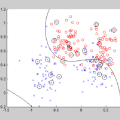In many real-world scenarios, obtaining large amounts of labeled data can be a daunting task. Weakly supervised learning techniques have gained significant attention in recent years as an alternative to traditional supervised learning, as they enable training models using only a limited amount of labeled data. In this paper, the performance of a weakly supervised classifier to its fully supervised counterpart is compared on the task of defect detection. Experiments are conducted on a dataset of images containing defects, and evaluate the two classifiers based on their accuracy, precision, and recall. Our results show that the weakly supervised classifier achieves comparable performance to the supervised classifier, while requiring significantly less labeled data.
翻译:在很多实际场景下,获取大量标记数据是一项艰巨的任务。近年来,弱监督学习技术作为传统监督学习的替代方法受到了广泛关注,因为它们可以仅仅使用有限的标记数据来训练模型。本文将在缺陷检测任务中比较弱监督分类器与传统监督分类器的性能。实验使用了一个含有缺陷的图像数据集,并根据准确率、精确度和召回率评估了两个分类器。结果表明,弱监督分类器在需要更少标记数据的情况下,可以实现与传统监督分类器相当的性能。




